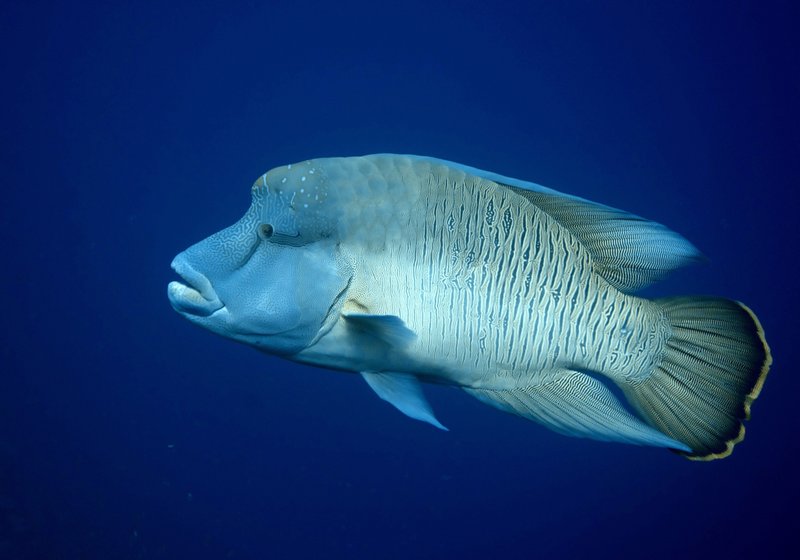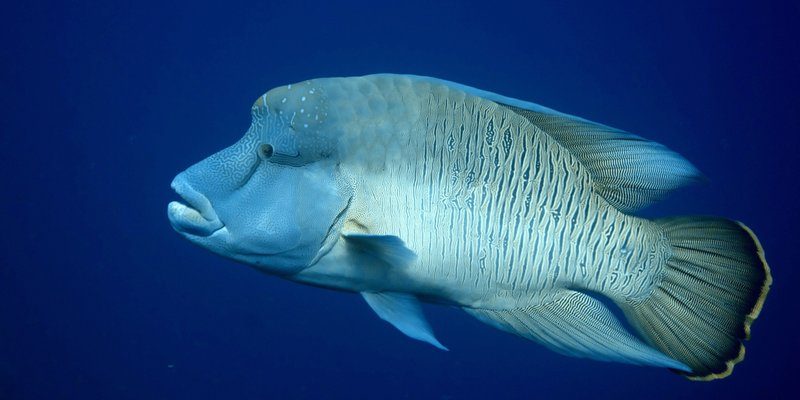
Have you ever seen a fish so colorful and big that it almost seems like it’s wearing a crown? The Napoleon Wrasse is one of those incredible creatures. With its vibrant turquoise body and prominent hump on its forehead, this majestic fish definitely stands out in the ocean. Imagine swimming alongside a living rainbow — that’s what encountering a Napoleon Wrasse feels like!
This unique fish is not just a pretty face; it plays a crucial role in marine ecosystems. It’s a key player in coral reef health, munching on sea urchins and other invertebrates that can otherwise overpopulate and damage the reefs. But there’s a lot more to learn about the Napoleon Wrasse — from its fascinating behaviors to its conservation status. Let’s dive right in!
Physical Characteristics
The Napoleon Wrasse, scientifically known as Cheilinus undulatus, is hard to miss. Adults can grow up to about 6 feet long and weigh over 400 pounds! Their striking color, ranging from bright blue to green, helps them blend in with the colorful reefs they call home. This fish is often recognized by a unique hump on its head, which develops more prominently as it matures.
Interestingly, young Napoleon Wrasses are quite different in appearance; they start out with a yellowish hue. As they grow, they undergo a transformation that adds to their stunning beauty. This shift is nature’s way of equipping them for life on the reef, where bright colors can help attract mates and establish territory.
Their large mouths are designed for crushing hard-shelled prey like sea urchins and mollusks. They also have sharp teeth arranged in a very specific way, allowing them to effectively grasp their food. Its striking features not only make it look impressive but also serve practical purposes for survival in its underwater world.
Habitat and Distribution
The Napoleon Wrasse thrives in warm, tropical waters. You can find them primarily in the coral reefs of the Indo-Pacific region, from the Red Sea to the coasts of East Africa, and as far as Hawaii and French Polynesia. They prefer shallow waters, typically around 10 to 100 feet deep, where they can easily access their favorite meals.
This fish has a somewhat limited range, tied closely to coral reef ecosystems. The reefs provide food, shelter, and breeding grounds essential for their survival. However, the health of these reefs is increasingly under threat due to climate change, pollution, and overfishing. As a result, the Napoleon Wrasse’s habitat is shrinking, and their future becomes more precarious.
Because they enjoy a benign environment, these fish are also sensitive to changes in water conditions. The presence of healthy coral reefs is crucial not only for their survival but for the entire biodiversity of their ecosystems. When reefs flourish, a vibrant community of marine life can thrive, highlighting how interconnected all creatures are in the ocean.
Diet and Feeding Habits
What does a Napoleon Wrasse eat? That’s a great question! These magnificent fish are primarily carnivorous. Their diet mainly consists of hard-shelled invertebrates like sea urchins, crabs, and various mollusks. They use their powerful jaws and teeth to crack open these tough shells, showcasing their impressive feeding technique.
Interestingly, the feeding behavior of the Napoleon Wrasse can also tell us a lot about their role in the ecosystem. By preying on sea urchins, they help maintain the balance on the reef. Too many sea urchins can lead to coral overgrazing, which can devastate the reef habitat. So, in a way, the Napoleon Wrasse acts as a natural gardener of the reefs!
Additionally, these fish are known to be quite social. They often hunt in groups, using cooperative strategies to catch their prey more efficiently. This social aspect adds another layer to their fascinating behavior, demonstrating how teamwork plays a role even in the underwater world.
Behavior and Social Structure
When it comes to social structure, the Napoleon Wrasse is quite intriguing. These fish are known to establish territories and may even show hierarchical social structures within their groups. Males tend to be more dominant, displaying more vibrant colors and larger humps than females. They often engage in elaborate courtship displays to attract mates, showcasing their beauty and strength.
Moreover, Napoleon Wrasses are highly intelligent creatures. They exhibit problem-solving abilities, which are rare among fish. For example, researchers have observed them using tools, like rocks, to break open shells. This kind of behavior reflects a level of cognitive complexity that many might not associate with fish, challenging our perception of their capabilities.
These fish also maintain strong social bonds. They can recognize individual fish and may even form friendships, showing a fascinating aspect of their social life. It’s not uncommon for Napoleon Wrasses to interact playfully with divers, which highlights their curiosity and friendly nature.
Reproduction and Lifespan
The reproduction process of the Napoleon Wrasse is just as fascinating as their physical traits. They are known to be protandrous hermaphrodites, meaning they start life as males and can transition to females later on. This unique reproductive strategy helps maintain a balanced population in their habitat.
During the breeding season, males establish territories to attract females. They perform complex courtships, which may include colorful displays and synchronized swimming. Once a female chooses a mate, they engage in a spawning ritual, releasing eggs and sperm simultaneously into the water. This event typically occurs at dusk, maximizing the chances of fertilization and ensuring the young have a better chance of survival.
Conservation Status
The conservation status of the Napoleon Wrasse is a growing concern. Classified as vulnerable by the IUCN, their populations are declining due to several factors. Overfishing, particularly for the live fish trade, poses a significant threat. Many people seek these beautiful fish for aquariums, leading to unsustainable fishing practices.
Habitat destruction due to climate change and pollution also plays a part in their decline. Coral reefs are increasingly affected by rising ocean temperatures, leading to bleaching events that harm not only Napoleon Wrasses but countless other marine species as well. Protecting these habitats is critical for the health of the entire ecosystem.
Efforts are underway to conserve the Napoleon Wrasse and its habitat. Marine protected areas (MPAs) are being established in many regions, offering a refuge for this magnificent fish. Additionally, awareness campaigns aim to educate the public about the importance of sustainable fishing practices and reef conservation. Every small effort can contribute to the survival of this enchanting species.
Interesting Facts About Napoleon Wrasse
| Scientific Name: | Cheilinus undulatus |
| Size: | Up to 6 feet (1.8 meters) |
| Weight: | Over 400 pounds (180 kg) |
| Average Lifespan: | 30 to 50 years |
| Habitat: | Coral reefs of the Indo-Pacific |
| Diet: | Carnivorous — sea urchins, mollusks, crabs |
FAQ
What does the Napoleon Wrasse eat?
The Napoleon Wrasse primarily feeds on hard-shelled invertebrates, such as sea urchins, crabs, and various mollusks. They have strong jaws that allow them to crush these prey items, which are essential for their diet and play a significant role in maintaining the health of coral reefs.
Where can I find Napoleon Wrasse?
You can find Napoleon Wrasse in the warm waters of the Indo-Pacific region, especially around coral reefs. These fish prefer shallow waters, making them easier to spot for divers and snorkelers. Countries like Indonesia, the Philippines, and the Great Barrier Reef in Australia are popular locations to see them.
How long do Napoleon Wrasse live?
Napoleon Wrasse can have a remarkably long lifespan, typically living between 30 to 50 years. Their longevity is one of the factors that make them vulnerable to overfishing, as they take a long time to reach maturity and reproduce.
Are Napoleon Wrasses social fish?
Yes, Napoleon Wrasses are quite social and often interact with each other. They establish territories and may form hierarchies, particularly among males. Their social behaviors include cooperative hunting and courtship displays, making them fascinating creatures to observe.
How do Napoleon Wrasse reproduce?
Napoleon Wrasses exhibit a unique reproductive strategy known as protandrous hermaphroditism. They start life as males and can change to females as they mature. During the breeding season, males attract females through elaborate displays and synchronized swimming before spawning in shallow waters.
Why are Napoleon Wrasses considered vulnerable?
Napoleon Wrasses are classified as vulnerable due to several threats, including overfishing, particularly for the live fish trade, and habitat destruction from pollution and climate change. Protecting their habitats and promoting sustainable fishing practices are crucial for their survival.
What is the significance of Napoleon Wrasse in the ecosystem?
Napoleon Wrasses play a vital role in maintaining the health of coral reef ecosystems. By preying on sea urchins and other invertebrates, they help prevent overgrazing of coral, allowing the reefs to thrive. This balance is essential for the preservation of diverse marine life.
Can I keep a Napoleon Wrasse as a pet?
While it’s technically possible to keep a Napoleon Wrasse in an aquarium, it’s not advisable for several reasons. They grow large, require vast swimming spaces, and have specific dietary needs that can be challenging to meet in captivity. Moreover, their conservation status makes it essential to prioritize their presence in natural habitats over personal ownership.
What threats do coral reefs face?
Coral reefs are under threat from climate change, pollution, overfishing, and habitat destruction. Rising ocean temperatures lead to coral bleaching, while pollution can harm marine life. Protecting these vital ecosystems is crucial for the survival of many species, including the Napoleon Wrasse.
How can I help in conservation efforts for Napoleon Wrasse?
You can contribute to conservation efforts by supporting marine protected areas, practicing sustainable tourism, and spreading awareness about the importance of preserving coral reefs and marine life. Every small action counts in protecting these magnificent creatures and their habitats.
What makes the Napoleon Wrasse unique among fish?
The Napoleon Wrasse is unique due to its vibrant coloration, large size, and social behavior. Its ability to change gender and its role in the health of coral reefs further set it apart from other fish species. These traits make it a fascinating subject for research and admiration.

